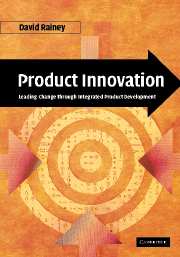Book contents
- Frontmatter
- Contents
- Preface
- Acknowledgements
- Part I Product innovation and strategic logic
- Part II Establishing the foundation: the conceptual level
- Part III Methods and techniques for analysis and decision making
- Part IV The operational level and concluding remarks
- 11 Design and Development (Phase 4)
- 12 Validation (Phase 5)
- 13 Pre-commercialization (Phase 6) and the launch
- 14 Concluding remarks and insights about product innovation in the twenty-first century
- Glossary
- References
- Select bibliography
- Index
14 - Concluding remarks and insights about product innovation in the twenty-first century
Published online by Cambridge University Press: 10 August 2009
- Frontmatter
- Contents
- Preface
- Acknowledgements
- Part I Product innovation and strategic logic
- Part II Establishing the foundation: the conceptual level
- Part III Methods and techniques for analysis and decision making
- Part IV The operational level and concluding remarks
- 11 Design and Development (Phase 4)
- 12 Validation (Phase 5)
- 13 Pre-commercialization (Phase 6) and the launch
- 14 Concluding remarks and insights about product innovation in the twenty-first century
- Glossary
- References
- Select bibliography
- Index
Summary
Introduction
This chapter adds insights on how leading organizations are improving their processes and techniques for developing high-quality, superior-performance, and low-cost products having superior reliability and durability. The demands are not only on the products, but also on the processes and the people involved. Effective companies have to create and launch new products with outstanding attributes and in record times. They have to create a positive climate for being the best and achieving superior outcomes.
Product innovation has evolved dramatically over the latter part of the twentieth century. Leading corporations have integrated product development into their organizational constructs and have progressed from the linear flow of project-management thinking to a more-dynamic and interactive process-management framework, attempting to maximize synchronization of the activities and speed to market. On a global basis, most large companies are using some form of integrated product development (IPD) and are incorporating contributions of their customers, stakeholders, supply networks, strategic partnerships, related industries, and stakeholders into the new-product development (NPD) process.
Product innovation in the twenty-first century continues to evolve as new methods and techniques become available. Nevertheless, the near-term challenges include how to maintain continuous improvement and to discover even better ways of leading and managing product innovation. Leading companies are exploring the means to develop products virtually and to improve further the effectiveness of their NPD programs.
- Type
- Chapter
- Information
- Product InnovationLeading Change through Integrated Product Development, pp. 568 - 585Publisher: Cambridge University PressPrint publication year: 2005



